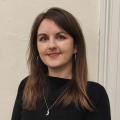Fermanagh fine artist Wendy Ferguson primarily works in oils to create her unique visual responses to her rural surroundings.
Concerned with colour, texture and shape, Wendy’s work is bold and eye-catching, inciting wonder and intrigue in those who view it.
Here she talks to the Impartial Reporter about her main artistic influences, where she exhibits her work and her favourite project to date.
JC: What is your artistic background?
WF: I’ve always been quite a creative person from a young age and enjoyed practical subjects in school. After I finished my A-Levels I got accepted to do a Foundation Diploma in Art and Design at Ulster University, Belfast in 2013. I knew that I wanted to further my education in the art industry and one day contribute in the Arts and Education sector. In 2016 I began a BA Honours Degree in Fine Art at Ulster University.
I graduated with a First Class Honours degree and was awarded the position of Artist in Residence at Ulster University for the following academic year. Through my resident year I had the opportunity to work with some very talented people in the university and in the industry whilst developing my own professional practice. I ended my resident year in 2017 with the award of Associate Fellow (AFHEA), of the Higher Education Academy.
JC:What inspires your art?
WF: My work is redolent of my sense of place in rural County Fermanagh which has preoccupied and informed my relationship with the rural, agricultural landscape and my visual response to it. I am concerned with colour, texture, shape and the possibilities of the medium’s tactile qualities operating to intensify each work’s presence.
JC: Who are your biggest influences?
WF: I have many artistic influences such as Robert Armstrong, Elizabeth Magill, Peter Doig and Hurvin Anderson to name a few. All brilliant painters all of whom have a connection to the landscape.
JC: What has been your most ambitious piece to date?
WF: I couldn’t possibly select one particular piece as I view them all as ambitious in their own way. However, I would definitely say my works on circular canvas are my particular favourites but equally as challenging to do. The circular structure was derived from the renaissance term known as a “Tondo” which questioned the frontier between painting and sculpture. This formation has become a vital part of my practice.
It allows the work to depart from the traditional rectangular configuration of landscape painting but also allows me to be a bit looser with my colour palette and style.
JC: What different artistic mediums do you use and which is your favourite?
WF: My main choice of medium is oil paint on canvas or paper. I also like to use oil bars and pastels to create varied marks and effects within the work.
JC: What are you currently working on?
WF: I’m currently working on completing a new collection of paintings for my upcoming solo show in March and developing new pieces for smaller group shows.
JC: Where do you exhibit your work?
WF: I’ve exhibited in beautiful venues North and South of Ireland. To name a few, Hambly and Hambly, Rathfarnham Castle, Finn Lough Resort, Artelier-Design and in the Royal Ulster Academy of Arts.
I’ve been very fortunate to have had the opportunity to exhibit in such venues and look forward to what lies in store for this year and the future.
JC: Any new artistic ventures planned for 2019?
WF: 2019 is setting up to be a busy year as I prepare for a solo show titled ‘This Land’ at the end of March in Ards Arts Centre.
‘This Land’ is a new series of oil paintings which explores the manipulation and process of oil paint through the subject of the Irish Landscape.
A number of group shows are in the pipeline also for the upcoming year.
JC: What has been your favourite project to date?
WF: Working as a scenic artist for the production of ‘RED’ at the Lyric Theatre in 2017. RED the story of the famous artist Mark Rothko in the late 1950’s at the height of his career, receiving the world’s largest commission.
I had the most amazing opportunity to replicate the famous Seagram murals for this production.
JC: What are you up to when you aren’t painting?
WF: When I’m not painting, I’m planning for my wedding day which will take place in the summer of this year.
JC: How would you describe your artistic style?
WF: My paintings lie somewhere between abstraction and representation.
I am interested in how paint behaves materially. My practice is very colourful, experimental and I’ve always been open to trying out new mediums and materials.














Comments: Our rules
We want our comments to be a lively and valuable part of our community - a place where readers can debate and engage with the most important local issues. The ability to comment on our stories is a privilege, not a right, however, and that privilege may be withdrawn if it is abused or misused.
Please report any comments that break our rules.
Read the rules here